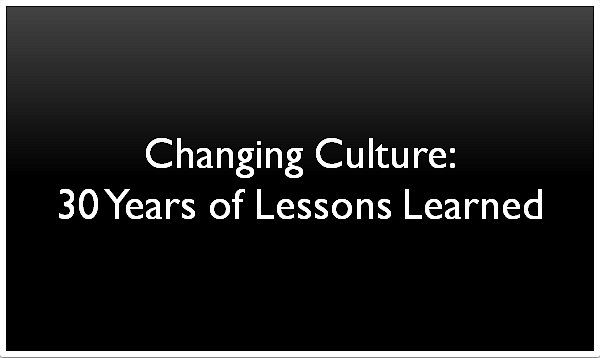How To Use A Network Of Practices To Shape And Change Culture
How To Use A Network Of Practices To Shape And Change Culture
Creating a culture by design is not easy, however, it is possible with the potential to achieve concrete results in a matter of months and not years as popularly believed. We’ve seen numerous examples in all sizes of companies across a wide range of industries and sectors that support this statement. In some cases, the change is dramatic and others less so but in everyone, leaders were the catalyst for the change that occurred. How did they do it? Here’s our guide to how to use a network of practices to shape and change culture.
How Are You Trying To Change Your Company’s Culture?
The first thing to understand is that in order to shift your company’s culture you have to identify some specific characteristics that you want to change. It is not enough to simply say “I want to improve my company’s culture.” You must know what exactly you want to change/improve and implement a related set of behaviors, practices and action strategies. Don’t worry about getting it perfect. Just focus on a few things and do them consistently, preferably with others. Let’s look at an example.
Challenging the Status Quo
In many organizations, days, weeks, months and even years go by with people doing the same thing the same way. In some cases, this is because of the current way of doing things works. It is the most effective and efficient approach currently known and available. The problem is that things change. The external environment is constantly in a state of flux challenging organizations to keep pace or fall behind. The emergence of new technologies, improved methods, and processes, new knowledge, competitors and innovations happen all the time. To thrive in this environment, organizations must be alert to what is happening in the world around them while at the same time questioning and challenging existing assumptions and searching for new and better ways of doing things.
Behaviors
Walk around and observe the work that is being done in your area or organization.
- Ask yourself, ‘why are we doing things this way?’
- If you can’t answer the question or are unhappy with your answer, ask the people performing the work the same question then ask, is there a better way of doing this? or what is stopping us from doing this another way?
Ask ‘what if’
- This is a powerful phrase as it often involves questioning another person’s actions but in a way that invites dialogue and encourages them to consider alternative approaches and scenarios.
- Look for situations where actions are being taken or decisions made because this is the way things have always been done.
Operating Practices
Use problem-solving situations to ask ‘what if’.
- Encourage others to also ask ‘what if’ by avoiding getting to a solution too quickly.
- Use a rapid brainstorming technique to surface as many ideas as possible as quickly as possible.
- Make it a rule that there is no critiquing of ideas until all possibilities are on the table.
- Consider inviting people who are outside or removed from the situation or problem to participate. They can sometimes be a source of ideas that people close to the situation can’t see.
Use problems, ideas and feedback from customers to identify and act on improvement opportunities.
- Create an on-line ‘suggestion box’ using a template that allows type classification and sorting.
- The suggestion box can be organized by an initial set of categories based on known problems and/or core business processes and work activities.
- It is important to allow more categories to be created as new issues and opportunities are encountered.
- Make sure to include at least one field to capture suggestions, recommendations, and ideas.
- Ask people to log the problems they encounter, suggestions for improvement, feedback from their customers, missed deadlines and deliverables, and so on.
- This can be anything that they want. Do NOT restrict the information that they enter.
- Set up a schedule to review each category, analyze the contents and develop action plans.
- Consider creating teams that have ownership for different categories and/or issues and opportunities.
Search Practices
Schedule a half day every month where employees can try out new approaches or experiment with new ways of doing things
- Structure these around key responsibility areas or core processes.
- People should be involved in things that they have an interest or stake in.
- Provide an approach to help them get started (see Fostering Creativity for suggestions) and consider using a facilitator until they learn how to do this effectively.
- This is an opportunity for people to try out things they’ve thought of in the past but has never been implemented or to take the time to think about and try ‘what ifs’. For example, “what if we stopped doing this?” or “what if we tried doing this differently?”
Use an approach such as Google’s grouplets: The Google Way: Give Engineers Room – New York Times to encourage people to voluntarily work on things that interest them.
- Google provides its engineers with 20% of their time to work on things that interest them.
- They can do this on their own or, as happens a lot of the time, in teams called ‘grouplets’.
- The grouplets have no budget or decision-making authority. They have people who are committed to an idea and willing to work to convince others to adopt it.
- There isn’t a formal approval process or directives from senior management. The burden is on the grouplet members to convince others.
- To minimize the risk of misalignment and duplicated effort, grouplet organizers meet once a week to review what is happening.
Action Strategies
Hold a scenario planning workshop.
- Scenario planning involves extrapolating a number of possible futures based on known factors and plausible trends. This encourages people to ‘think the unthinkable’.
- After the future scenarios are identified, people work together to answer questions such as, “what do we need to do now to be ready for all possible scenarios?” This leads to the development of action plans that, when effective, address the majority of scenarios the organization may face.
- Information on how to conduct scenario planning is available at the following link: http://www.jiscinfonet.ac.uk/tools/scenario-planning.
Ask your team to read and discuss what can be learned from the Superstruct Game that was conducted in 2008 and played by over 8,000 people from around the world.
- The game archive can be found at: Welcome to the Superstruct Game Archive
- The game required players to forecast future scenarios for the year 2019. It provides an excellent example of a large scale scenario planning exercise. You can use insights gained from the Superstruct approach and its outcomes to conduct a scenario planning exercise in your organization.
Organize an external search initiative.
- Invite people to participate in an initiative to explore what other organizations in other industries or sectors are doing and how you might be able to apply this to your organization.
- Select an industry or organization that is very different from yours and has a reputation for excelling in something that you are interested in or need e.g. a hospital system striving to embed patient-centered care in its culture might research an organization known to excel in providing an outstanding customer experience.
- Ask people to answer one question such as “what is this organization doing that makes them excel at…”
- They can do this in small teams or individually.
- Set a time frame that is realistic but not too long for their research.
- If possible, provide an opportunity for them to visit the target organization or meet in person or virtually with people in relevant roles so they can see and hear for themselves what the other organization is doing.
- Consider providing people with time to do the exercise e.g. ½ day booked off from other work activities.
- Bring everyone together at the end of the research period to do some brainstorming (or other creative problem-solving technique) of ideas that can be applied in your organization.
Question the existing belief system of your organization.
- A belief is an approach, way of working and so on that people view as required to be successful. For example, look at the way important decisions are made. If these are made by consensus, it likely indicates the belief that the collective makes better quality decisions than individuals or taking the time to get everyone in agreement means that implementation will be faster and smoother.
- Be warned that this is not an easy task. It requires identifying the often unspoken belief systems that have been embedded in all aspects of the organization including its structure, processes and so on.
Questions you can ask yourself and others that can be helpful are:
- What are the ‘sacred cows’ in this organization?
- These are the inviolable and unspoken rules that everyone must follow. For example, an unspoken rule in an oil company was that, regardless of its perceived value, you must ‘follow the process’, ‘complete the tasks on a checklist’ and so on. This developed from the belief that, as an organization that has the potential to have a massive environmental impact, compliance to policies and processes is essential. This got to the point where there was evidence of unquestioning compliance including the completion of tasks that had no value.
Once you’ve identified a ‘sacred cow’ continue with questions such as…
- Why do we comply with these unspoken ‘rules’?
- What would happen if we didn’t do this or did it differently?
- What is stopping us from doing something different?
- What do we as a collective believe is important in the way we interact with each other, do our jobs, serve our customers and so on?
How is this revealed in the way we do things on a day-to-day basis?
- Ask for stories to illustrate the beliefs that are identified. This will help to determine if it is real or hypothetical.
- What if we did things differently? What would happen?
If you need help shaping or changing your company’s culture check out our products and services at CultureStrategyFit today!










